AOD Use in Australia
Snapshot of Alcohol, Tobacco and other drug use in Australia
The following data comes from the 2019 National Drug Strategy Household Survey (NDSHS). The NDSHS collects information on alcohol and tobacco consumption, and illicit drug use among the general population in Australia. It also surveys people's attitudes and perceptions relating to tobacco, alcohol and other drug use. The survey has been conducted every 2 to 3 years since 1985. The Australian Institute of Health and Welfare (AIHW) has been collating and reporting on these surveys since 1998.
How often do Australians drink alcohol and how did this change between 2016 and 2019?
Between 2016 and 2019 increasing numbers of Australians stopped drinking alcohol. While more young adults were abstaining from alcohol, older people were more likely to drink daily. The proportions of people drinking daily and weekly have been falling since 2004 and are now at the lowest level in 20 years.
Drinking frequency among people aged 14 and older, 2001–2019 (per cent)
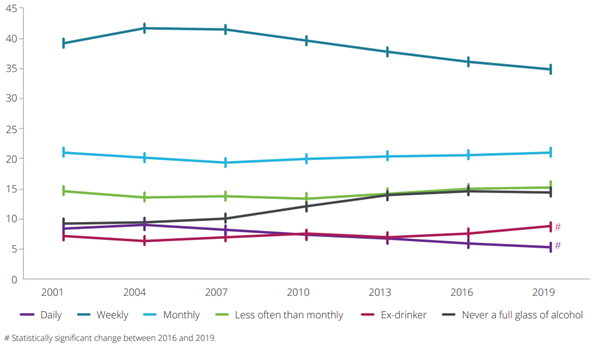
Source: AIHW (2020)
What proportion of Australians drink at harmful levels?
In December 2020, the National Health and Medical Research Council (NHMRC) revised the Australian guidelines to reduce health risks from drinking alcohol (NHMRC 2020). These guidelines were created following a review of the health effects of consuming alcohol. The guidelines define drinking behaviours that Australians can follow to reduce their risk of alcohol-related disease or injury.
Using these guidelines, healthy men and women aged 18 years and over are classified as having consumed alcohol in ways that reduce their risk of experiencing alcohol-related disease or injury if, in the past 12 months, they reported that they:
- Consumed no more than 10 standard drinks per week on average; and
- Never consumed more than 4 standard drinks on a single day (or did so less often than once per month on average).
In contrast, people who reported drinking more than 10 standard drinks per week or who drank more than 4 standard drinks on a single day at least once a month on average, are classified as having consumed alcohol in ways that increased their risk of harm (AIHW, 2021).
Using the revised definitions of risky drinking, in 2019 1 in 3 adults (33%) consumed alcohol at levels that increased their risk of alcohol-related disease or injury. This was slightly lower than the proportion of people who did so in 2016 (35%). This continued a generally declining trend evident since 2004, when 40% of adults consumed alcohol at risky levels (AIHW, 2021).
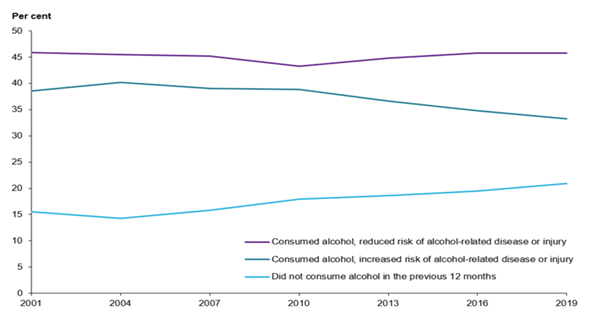
Source: AIHW (2021)
How many people smoke tobacco and how did this change between 2016 and 2019?
Since 1991, the proportion of daily smokers in Australia has more than halved, while the proportion never taking up smoking has increased (from 49% in 1991 to 63% in 2019). The proportion of ex-smokers has remained fairly stable over this period and did not change between 2016 and 2019 (23%). In 2019, 11.0% of people aged 14 and over smoked daily, declining from 12.2% in 2016.
The decrease in daily smoking appears to be mainly driven by fewer people aged 14–39 taking up smoking between 2001 and 2019. For example, the proportion of young adults aged 18-24 who had never smoked more than 100 cigarettes in their lifetime increased from 58% to 80% between 2001 and 2019, while among people in their 50s this only increased from 44% to 51%.
Tobacco smoking status, people aged 14 and over in Australia 1991–2019 (per cent)
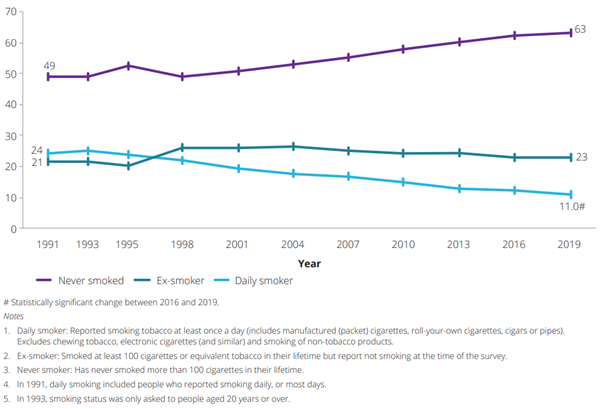
Source: Australian Institute of Health and Welfare 2020. National Drug Strategy Household Survey 2019. Drug Statistics series no. 32. PHE 270. Canberra: AIHW.
How many Australians have used illicit drugs and how did this change between 2016 and 2019?
In 2019, 9.0 million (43%) people aged 14 years and over in Australia had used an illicit drug at some point in their lifetime (including pharmaceuticals used for non-medical purposes) and 3.4 million (16.4%) had done so recently (in the last 12 months). The proportion of Australians using illicit drugs in the past year was similar in 2016 but has increased since 2007 (38.0% and 13.4% respectively). See diagram for changes in lifetime and recent use of specific drugs between 2016 and 2019.
Changes in lifetime and recent use of specific drugs between 2016 and 2019.
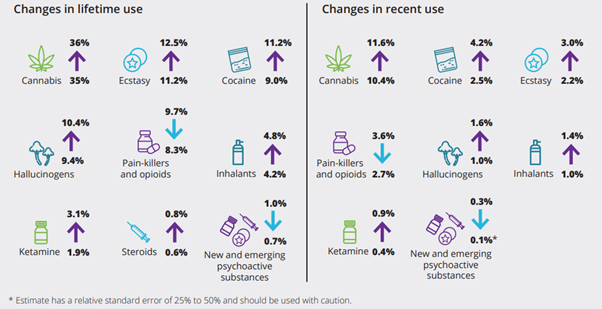
Source: Australian Institute of Health and Welfare 2020. National Drug Strategy Household Survey 2019. Drug Statistics series no. 32. PHE 270. Canberra: AIHW.
How many Australians have used amphetamines and how did this change between 2016 and 2019?
Meth/amphetamine use has been declining since peaking at 3.4% in 2001 and stabilised in 2019 (1.4% in 2016 and 1.3% in 2019). While no statistically significant changes by age or sex were detected between 2016 and 2019, use has been declining among younger age groups since 2001 but increasing or remaining stable among older age groups (40 years and over).
Lifetime and recent use of meth/amphetamines, by age, 2001–2019 (per cent)
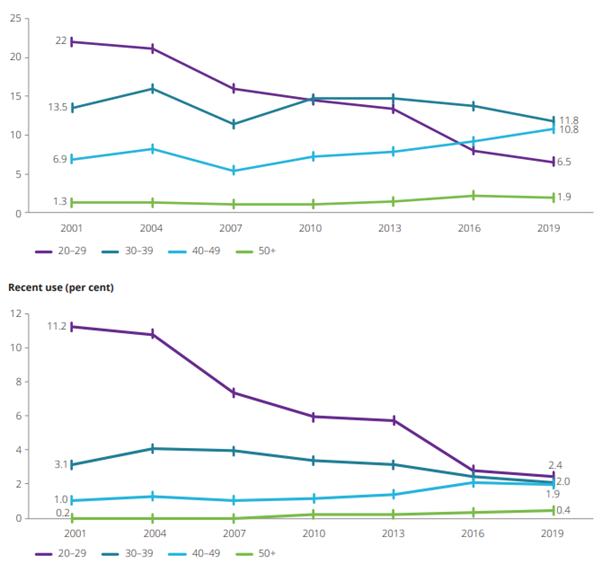
Source: Australian Institute of Health and Welfare 2020. National Drug Strategy Household Survey 2019. Drug Statistics series no. 32. PHE 270. Canberra: AIHW.
How many Australians have used use cannabis and how did this change between 2016 and 2019?
Cannabis is the most common illicit drug used in Australia and prevalence of both lifetime and recent use is increasing. In 2019, 36% of Australians had used the drug in their lifetime (up from 35% in 2016) and 11.6% had used it in the last 12 months (up from 10.4%). In addition, more people reported using it in the month before the survey (from 5.8% to 6.6%) but there was no change in the frequency of use. Approximately half of those who used cannabis did so monthly or more frequently. The increase in lifetime use was due mainly to an increase among people aged 60 and over (from 13.8% to 18.9%). This could be due to an ageing cohort of people who had used cannabis, an increase in people deciding to try it, or to more people being willing to report their use.
Cannabis use among older Australians 2001-2019.

Source: Australian Institute of Health and Welfare 2020. National Drug Strategy Household Survey 2019. Drug Statistics series no. 32. PHE 270. Canberra: AIHW.
References
Australian Institute of Health and Welfare (2020). National Drug Strategy Household Survey 2019. Drug Statistics series no. 32. PHE 270. Canberra: AIHW.
Australian Institute of Health and Welfare (2021). Measuring risky drinking according to the Australian alcohol guidelines. Accessed 20 April, 2021 at https://www.aihw.gov.au/reports/alcohol/measuring-risky-drinking-aus-alcohol-guidelines/contents/measuring-risky-drinking
National Health and Medical Research Council (2020). Australian Guidelines to Reduce Health Risks from Drinking Alcohol. Canberra: NHMRC.
Other Resources
National Alcohol and Drug Knowledgebase
The National Alcohol and Drug Knowledgebase (NADK) was developed by NCETA with support from the Australian Government Department of Health. The NADK is a website that draws on the highest quality Australian data to provide accurate, easy-to-understand and up-to-date information about alcohol and other drugs.
National Drug Strategy Household Survey
The National Drug Strategy Household Survey (NDSHS) is conducted every three years by the Australian Institute of Health and Welfare. The survey has a sample of approximately 25,000 Australians and provides the best population level prevalence data regarding alcohol, tobacco and other drug use.
National Wastewater Drug Monitoring Program reports (Australian Criminal Intelligence Commission)
The National Wastewater Drug Monitoring Program (NWDMP), which commenced in August 2016, provides leading-edge, coordinated national research and intelligence on both licit and illicit drug use. It has a specific focus on methylamphetamine and other high-risk substances such as alcohol. The Program is a key initiative in establishing an objective evidence base on illicit drug use and the level of use of a number of legitimate substances that can be misused.
Reports from the NWDMP are available here.
Illicit Drug Data Report (Australian Criminal Intelligence Commission)
The Illicit Drug Data Report (IDDR) informs Australia’s understanding of the illicit drug markets and focuses collective efforts by bringing together data from a wide range of sources into the one report. The Australian Criminal Intelligence Commission collects data annually from all state and territory police services, the Australian Federal Police, the Department of Home Affairs, the Australian Border Force, state and territory forensic laboratories and research centres. Data collected and presented in the report includes drug-related arrest, detection, seizure, purity, profiling and price data. Illicit drugs reported on include cannabis, heroin, amphetamine-type stimulants, and cocaine etc.
Illicit Drug Data Reports are available here.
Australian School Students Alcohol and Drug Survey
The Australian School Students Alcohol and Drug Survey is conducted every three years to ascertain the prevalence of alcohol, tobacco and other drug use amongst school students aged 12-17 years. Results are available here.
Illicit Drug Reporting System and Ecstasy and Related Drugs Reporting System
The Illicit Drug Reporting System (IDRS) and Ecstasy and Related Drugs Reporting System (EDRS) are managed by the National Drug and Alcohol Research Centre. These data collections monitor the price, purity, availability and patterns of use of illicit drugs.
IDRS reports are available here.
EDRS reports are available here.
Australian Bureau of Statistics
The Australian Bureau of Statistics (ABS) produces a number of statistical reports relevant to the alcohol and other drugs area.
